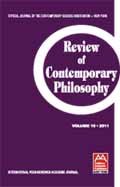NONSENSE AND ABSURDITY: CARNAP’S USE OF HUSSERL’S THEORY OF MEANING
NONSENSE AND ABSURDITY: CARNAP’S USE OF HUSSERL’S THEORY OF MEANING
Author(s): Andreas VrahimisSubject(s): Philosophy
Published by: Addleton Academic Publishers
Keywords: nonsense; absurdity; meaning; Carnap; Husserl; Heidegger
Summary/Abstract: In his Logical Investigations (Husserl 2001), Edmund Husserl introduced an innovative view of the theory of meaning, which subsequently influenced the development of Logical Positivism. According to Husserl, non-meaningful expressions may fall under one of two types: they are either absurd or nonsensical. Absurdity [Widersinn] is found in expressions which are contradictory, yet whose parts are combined in such a way as not to break the rules of logical syntax, as for example in the expression ‘a round square’. Nonsense [Unsinn], on the contrary, results from a breach of syntactic rules, such as may be found in the expression ‘a round or’. According to Husserl, absurdity results from a breach of the conventions that characterize ‘the contingent linguistic habits of a community’, whereas nonsense takes place when a priori universal laws of grammar are not followed. Following Husserl, Rudolf Carnap makes a distinction between logical and historico-grammatical syntax (Carnap 1959). For Carnap, as for Husserl, the breach of the first results in nonsense, whereas not following the second results in mere contradiction. In Carnap’s hands, Husserl’s distinction takes on radical implications for the practice of philosophy. Whereas, throughout history, contradiction has been a central elenchtic principle for philosophical discourse, Carnap claims that nonsense was a common error philosophers had made unbeknownst to themselves. Precisely since nonsense is defined as the breach of logical syntax, our historico-grammatical syntactic conventions allow for it to pass unnoticed. It is only with the development of modern logic that nonsensical expressions or, as Carnap puts it, ‘pseudo-concepts’ and ‘pseudo-statements’ may be detected by philosophers. This implies that an immense part of philosophical discourse throughout history has been, unbeknownst to its authors, subject to elementary errors. In a paper titled ‘Overcoming Metaphysics through the Logical Analysis of Language’, Carnap pinpoints something which he calls ‘metaphysics’ as a product of these elementary errors: the ‘numerous metaphysicians of the past and the present’ had not known that many of the concepts and statements they had been producing can be shown to be neither true nor false, and therefore are nonsensical. Notoriously, Carnap’s examples of nonsensical ‘pseudo-sentences’ are taken from a text written by Husserl’s pupil, Martin Heidegger, titled ‘What is Metaphysics?’. It is thus puzzling to see that Carnap makes no mention of Husserl in this paper; his radical claims regarding the meaninglessness of metaphysics disguise his own encounter with the phenomenological tradition, including his acquaintance with the work of both Husserl and Heidegger.
Journal: Review of Contemporary Philosophy
- Issue Year: 2011
- Issue No: 10
- Page Range: 133-140
- Page Count: 8
- Language: English
- Content File-PDF

